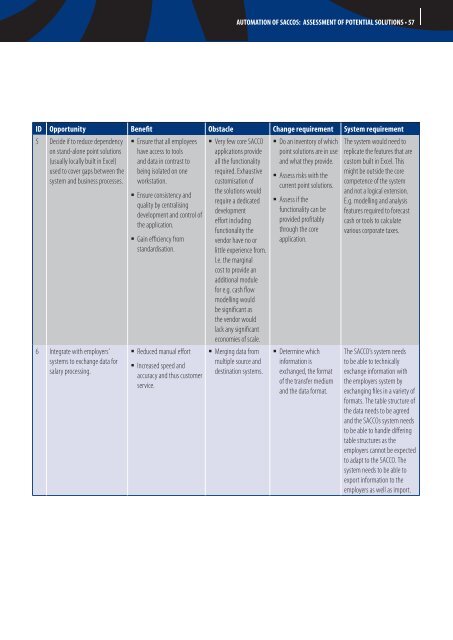Automation of SACCOs - FSD Kenya
Automation of SACCOs - FSD Kenya
Automation of SACCOs - FSD Kenya
Create successful ePaper yourself
Turn your PDF publications into a flip-book with our unique Google optimized e-Paper software.
AUTOMATION OF SACCOS: ASSESSMENT OF POTENTIAL SOLUTIONS • 57<br />
ID opportunity Benefit obstacle Change requirement System requirement<br />
5 Decide if to reduce dependency<br />
on stand-alone point solutions<br />
(usually locally built in Excel)<br />
used to cover gaps between the<br />
system and business processes.<br />
6 Integrate with employers’<br />
systems to exchange data for<br />
salary processing.<br />
Ensure that all employees<br />
have access to tools<br />
and data in contrast to<br />
being isolated on one<br />
workstation.<br />
Ensure consistency and<br />
quality by centralising<br />
development and control <strong>of</strong><br />
the application.<br />
Gain efficiency from<br />
standardisation.<br />
Reduced manual effort<br />
Increased speed and<br />
accuracy and thus customer<br />
service.<br />
Very few core SACCO<br />
applications provide<br />
all the functionality<br />
required. Exhaustive<br />
customisation <strong>of</strong><br />
the solutions would<br />
require a dedicated<br />
development<br />
effort including<br />
functionality the<br />
vendor have no or<br />
little experience from.<br />
I.e. the marginal<br />
cost to provide an<br />
additional module<br />
for e.g. cash flow<br />
modelling would<br />
be significant as<br />
the vendor would<br />
lack any significant<br />
economies <strong>of</strong> scale.<br />
Merging data from<br />
multiple source and<br />
destination systems.<br />
Do an inventory <strong>of</strong> which<br />
point solutions are in use<br />
and what they provide.<br />
Assess risks with the<br />
current point solutions.<br />
Assess if the<br />
functionality can be<br />
provided pr<strong>of</strong>itably<br />
through the core<br />
application.<br />
Determine which<br />
information is<br />
exchanged, the format<br />
<strong>of</strong> the transfer medium<br />
and the data format.<br />
The system would need to<br />
replicate the features that are<br />
custom built in Excel. This<br />
might be outside the core<br />
competence <strong>of</strong> the system<br />
and not a logical extension.<br />
E.g. modelling and analysis<br />
features required to forecast<br />
cash or tools to calculate<br />
various corporate taxes.<br />
The SACCO’s system needs<br />
to be able to technically<br />
exchange information with<br />
the employers system by<br />
exchanging files in a variety <strong>of</strong><br />
formats. The table structure <strong>of</strong><br />
the data needs to be agreed<br />
and the <strong>SACCOs</strong> system needs<br />
to be able to handle differing<br />
table structures as the<br />
employers cannot be expected<br />
to adapt to the SACCO. The<br />
system needs to be able to<br />
export information to the<br />
employers as well as import.
















